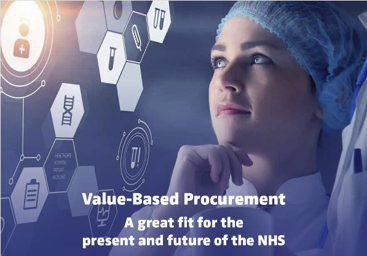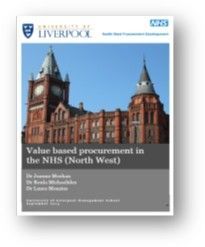News

Luach Consulting Group and its partner organisation, Hill Dickinson, have been developing and promoting the benefits of transitioning towards a value-based approach to procurement and healthcare for a decade. Significant progress has been made in recent years, with the completion of a national VBP proof-of-concept project sponsored by NHS Supply Chain and subsequently developed further by the Medtech Directorate of the Department for Health and Social Care. This article considers how value-based approaches are emerging as a means to deliver improved patient care, increase efficiency in clinical practice, and reduce the total costs of care. It is closely aligned with the objectives outlined in the recently published NHS Fit for the Future (FFTF) strategy. As the value paradigm reshapes the healthcare landscape, Luach Consulting Group stands uniquely equipped to help your organisation lead the way and unlock its full potential, contact us for an exploratory discussion. Click on the link below to download the full article.

On 22nd May 2025 Luach Consulting Group, in partnership with law firm Hill Dickinson, held the second in a series of events focussed on accelerating the adoption of value- based procurement (VBP). Our initial event, in October 2024 was extremely successful and identified six key areas of development including: The need to be clear about what is meant when we use the term ‘value’ to bring about widespread VBP adoption Aligning the NHS finance regime to recognise and incorporate value The need to evidence and contract for the delivery of value in the NHS - harnessing the power of data and measurement Incentivising a longer-term focus Creating a visible pipeline of VBP activity Maintaining a consistent agreed communications strategy for VBP adoption This second event in May 2025 picked up these themes with the aim of both assessing progress in addressing these areas; and engaging with the wider clinical and NHS finance community to promote wider stakeholder support and involvement. Whilst the event pre-dated the publication of the new 10 year plan for the NHS “Fit for the future”, it is highly encouraging to see that the work the group has undertaken is closely aligned with the ambitions of the Government strategy in terms of its focus on the delivery of value, productivity, improved patient outcomes and promotion of innovation. If you would like to receive a copy of the report please email us at consult@luachcg.com

The NHS is increasingly committed to Value-Based Procurement (VBP) and is planning to implement a standard evaluation methodology and we are also seeing health systems in Europe and the Middle East establishing projects to explore the benefits of procuring for value. This presents a fantastic opportunity for industry players to align their products and solutions with NHS needs. We've recently launched an e-learning course designed to upskill staff in sales, marketing, market access, and customer services. This course is versatile enough to apply to any country, focusing on the universal principles of what value means to healthcare. Key Features: • Cost-Effective and Quick: An efficient way to upskill your workforce. • Subtitles Available: Includes subtitles and can be translated into other languages on demand. • Broad Applicability: Ideal for entry-level training and adaptable to various regions. Explore the Course: To find out more details please email us at consult@luachcg.com

2025 has started with the publication of the report from the Department for Health and Social Care and NHS England on the need for reforms to elective care for patients served by the English NHS. The report sets out its proposals to reduce the elective backlog of clinical procedures which stands (of January 2025) at circa 7 million. The aim is that by 2029 the NHS will ensure that 92% of patients receive treatment within 18 weeks. This briefing document considers how a value based approach to procurement can support reforms to elective care for patients, and is intended as supporting material that can be used by LCG clients to align their messaging to the needs of the NHS.

It was encouraging to see that the new Government had commissioned a review of the NHS within its first 100 days. The purpose of this article is to consider some of the key messages and findings from Lord Darzi’s report through the lens of a value based approach to procurement. Productivity The report states at length about the fact that staff are working harder than ever and still experiencing challenges increasing productivity across the system. The lack of capital funding and assets is cited as a major contributor to this inefficiency, coupled to the need to improve patient flow throughout the system. A reduction in length of stay, greater use of day case surgery and releasing bed capacity through the application of technologies that enable patients to be treated at home, are all cited as desirable ways of working for the NHS. Through the initial Value Based Procurement (VBP) pilot project undertaken by NHS Supply Chain, there are several case studies that have been written where these objectives have been achieved across different pathways 1. Given that there was limited investment in the resources to undertake the proof of concept pilot, it would appear that wider adoption and application of VBP across multiple strategic areas has the potential to make a significant impact to the productivity goals cited in the report. Sustainability Through focusing on pathway optimisation, it was also identified in the NHS Supply Chain project 2, that per procedure a VBP approach has the potential to reduce carbon emissions, for example through reduced theatre time with the use of minimally invasive technologies and reduction patient travel through remote monitoring and care provided in a patients home. Value creation Lord Dazi refers to “value creation” in the report. The challenge, as I know from experience of VBP, is the need for the NHS to be clear what value means and translate this into tangible and measurable objectives/outcomes. When explaining how to adopt a value based approach to procurement professionals, I have recommended they undertake and analysis of treatment pathways to identify what needs to change and by how much, a simple but effective approach. This exercise allows suppliers and healthcare stakeholders to focus in on the needs of the NHS and the patient, and enables them to explore and garner resources to create solutions that effectively address the challenges identified. Partnerships There is a line from the TV sitcom “The Office” from the late 1990’s that goes something like..”just when we thought we saw the light end the end of the tunnel, it was someone with a torch bringing us more work!” To think that our NHS staff without support, have either the enthusiasm or the capacity to deliver the changes at the scale and pace required is unrealistic. Through VBP we have the opportunity to move from competition to collaboration with industry partners and create win/win relationships that can draw upon suppliers’ knowledge, skills and resources to accelerate the pace of change necessary and reduce the burden on already overstretched front line staff. Continuing the theme of collaboration, I call upon suppliers both MedTech and pharma to consider working together across pathways where they do not compete on product sales to create a single solution. This could potentially increase efficiencies for participating suppliers and healthcare professionals, reduce project management/support teams and free up resource across the supply chain. Finance In my experience of the NHS, I have witnessed examples of where financially favourable solutions over the life of a 2 year + contract have been rejected in favour of alternatives that generated a larger in-year saving; this is deemed necessary in some quarters of the NHS as accepted practice to balance the books. I’m no finance expert but intuitively does this approach make sense? Surely a longer term view would have more positive impact on the overall NHS finance position. When considering the delivery of value across a patient pathway, there may be higher upfront costs in one part of the system EG the Acute sector, which then results in lower total treatment costs when taking into account expenditure on community care. It is encouraging to see the importance of Integrated Care Systems highlighted in the Lord Darzi’s report and the hope is that ICB’s fully embrace whole health economy approaches to financial flows. It’s my assertion that there needs to be a restructure and commercialisation of the NHS finance regime; one that transitions to multiyear budgets, bundled payments based on targets for specific deliverables, and allows flexibility to introduce commercial incentives for over performance. These moves I believe will provide the stimulus for the creation of value and mechanisms for Healthcare and industry to work together in the co-creation of solutions that reduce total pathway costs, increase efficiency, and improve patient care. Conclusion Having had recent first-hand experience of the NHS as a patient in both NHS Wales and England, I am eternally grateful to live in a country where we have access to skilled health professionals who genuinely care for patients’ health and their wellbeing. As someone that has worked in an around the NHS for 20 years, I’m also acutely aware that this desire to “make a difference” is very much in the DNA of healthcare procurement professionals in the UK and around the world, and one of the reasons why people are attracted and stay in profession. In this article my aim has been to highlight that by adopting a value based approach will maximise the potential of procurement in playing a vital role supporting the NHS to meet the challenges set out in Lord Darzi’s report. Brian Mangan FCIPS MSc CEO Luach Consulting Group 1 VBP Case Studies » NHS Supply Chain 2 NHS Supply Chain Sustainability

Welcome to the Procuring Value in Healthcare Foundation e-Learning Course Discover how procurement can be a powerful lever for delivering better healthcare. This affordable, internationally relevant course is designed for clinical, finance, operations, and procurement professionals across health systems. Through a concise introductory video, you'll learn how strategic procurement can improve patient outcomes, enhance efficiency, reduce total costs of care, and support environmental sustainability. Whether you're new to value-based approaches or looking to deepen your impact, this course offers practical insights you can apply immediately.

One of the most popular games of chance in the world is the lottery, we have the Euro Millions, Mega Millions in the US and a whole range of national lotteries and Lottos…there are vast numbers of people who play this in the hope that they will win the big prize and it will change their life forever. Healthcare can also be a lottery, but instead of needing to pick the right six numbers in sequence, you need to have the right letters and numbers in your postal code to become a winner in the game of healthcare provision. As the CEO of Luach Consulting Group and Board Member for the European Association of Value Based Healthcare (EAVBHC), I have view that quality and affordable healthcare shouldn’t be a game of chance, but that it’s the right of all citizens. The belief is that the adoption of value based healthcare is key to addressing these inequalities and was a question posed to a group of multidisciplinary stakeholders from around the world at the EAVBHC session I led at the ICHOM Conference in Barcelona in 2023. In this short article consideration is given to how to increase the chances of winning on the VBHC lottery, by focusing on the ‘what’, the ‘how’ and the ‘when’ to implement a value based approach to healthcare. The What Value is a homonym. A word that can and does mean different things to different people. In the context of value based healthcare there is an agreed definition that value means improved patient outcomes at lower cost. However there remain a number of challenges with this i.e. How do we define and outcome, what tangible benefits are being delivered? Who is responsible for defining the outcome – the healthcare professional or the patient? How to we know the outcome has been achieved, what measures do we need to use? Opinions from the assembled delegates at the EAVBHC session, particularly clinical colleagues, was focused very much on the fact that the patient should be at the centre of determining what an outcome should look like. However, within the group and the wider ICHOM conference the view was generally that this was easier said than done. Patients are people and we are all diverse in our views as to what we want, and therefore health systems need to create mechanisms that can accurately reflect the overall consensus of what is desired and required. That said we are living in world of limited financial resources, whether we like it or not delivering value based healthcare at scale requires that the stated outcomes are affordable. This balance between clinical and commercial is traditionally fraught with tensions, largely down to traditional behaviours and tug of war between front line care staff (resources) and hospital administrators (finance). In determining the “what”, patient groups, healthcare registries, ICHOM and the use of organisations such as the EAVBHC could all be a rich source of information for systems looking to specify the desired outcomes as a starting point for a value based approach. The How Despite the fact that VBHC has been around for many years, there is still much debate as to how it can be introduced, to increase the chances of success, I’ve recommended these three steps to help you: 1. Establish a coalition to support the change - The drivers for system change towards value are predominantly through the efforts of clinical leaders, with one colleague from Brazil in the group clearly passionate about the need for a value approach, yet frustrated at the speed and process of adoption. in South Africa they are fortunate to have system leaders, such as the COO at Healthforce, who are enlightened and can set the strategy to facilitate a more value based approach. A third level of creating momentum is through the leadership of Healthcare Commercial, (both finance and procurement), with examples being shared by both Canada and the UK. The authors experience and assertion is that for a value based strategy to have any chance of being implemented, there needs to be a blended approach and commitment from both clinical, senior leadership and commercial stakeholders to commit resources and energy to delivering the programmes. If you can garner support from political leaders, then this will allow you to move at pace and scale. 2. Create system learning - by a developing and delivering a comprehensive education package available for both internal stakeholders (Clinical. Operations, Finance and Commercial) groups and external (Industry partners) focusing on the principles, practices and system interconnections relating to value based practices. 3. Be incremental - In the same way you wouldn’t go out and run a marathon after being on the couch for a lifetime, its about taking small steps. In this case by creating pilot studies that can be used to help test how best value can be adopted in your health system, allowing you to highlight any challenges in a controlled environment and create solutions to address them. The When I’m sure we’ve all experienced the challenge of the “should” when it comes to going on a diet, exercising or going back to study, the hardest part is actually starting. We plan, we strategize and put things off until finally something happens that forces us to take action. Health systems need to recognise the burning platform for change that exists in terms of increasing demand set against a backdrop of limited financial resources; and that by failing to address health inequalities now we will only make the situation worse. Like many of the delegates and health systems attending the session and the ICHOM conference, it is clear to me that the time to take action is now. Brian Mangan FCIPS CEO Luach Consulting Group www.luachcg.com Board member European Association of Value Based Healthcare EUROPEAN ASSOCIATION OF VALUE-BASED HEALTH CARE -Your health, your choice- (eavbhc.org)

Luach Consulting Group and its partner organisation, Hill Dickinson, have been developing and promoting the benefits of transitioning towards a value-based approach to procurement and healthcare for a decade. Significant progress has been made in recent years, with the completion of a national VBP proof-of-concept project sponsored by NHS Supply Chain and subsequently developed further by the Medtech Directorate of the Department for Health and Social Care. This article considers how value-based approaches are emerging as a means to deliver improved patient care, increase efficiency in clinical practice, and reduce the total costs of care. It is closely aligned with the objectives outlined in the recently published NHS Fit for the Future (FFTF) strategy. As the value paradigm reshapes the healthcare landscape, Luach Consulting Group stands uniquely equipped to help your organisation lead the way and unlock its full potential, contact us for an exploratory discussion. Click on the link below to download the full article.

On 22nd May 2025 Luach Consulting Group, in partnership with law firm Hill Dickinson, held the second in a series of events focussed on accelerating the adoption of value- based procurement (VBP). Our initial event, in October 2024 was extremely successful and identified six key areas of development including: The need to be clear about what is meant when we use the term ‘value’ to bring about widespread VBP adoption Aligning the NHS finance regime to recognise and incorporate value The need to evidence and contract for the delivery of value in the NHS - harnessing the power of data and measurement Incentivising a longer-term focus Creating a visible pipeline of VBP activity Maintaining a consistent agreed communications strategy for VBP adoption This second event in May 2025 picked up these themes with the aim of both assessing progress in addressing these areas; and engaging with the wider clinical and NHS finance community to promote wider stakeholder support and involvement. Whilst the event pre-dated the publication of the new 10 year plan for the NHS “Fit for the future”, it is highly encouraging to see that the work the group has undertaken is closely aligned with the ambitions of the Government strategy in terms of its focus on the delivery of value, productivity, improved patient outcomes and promotion of innovation. If you would like to receive a copy of the report please email us at consult@luachcg.com

The NHS is increasingly committed to Value-Based Procurement (VBP) and is planning to implement a standard evaluation methodology and we are also seeing health systems in Europe and the Middle East establishing projects to explore the benefits of procuring for value. This presents a fantastic opportunity for industry players to align their products and solutions with NHS needs. We've recently launched an e-learning course designed to upskill staff in sales, marketing, market access, and customer services. This course is versatile enough to apply to any country, focusing on the universal principles of what value means to healthcare. Key Features: • Cost-Effective and Quick: An efficient way to upskill your workforce. • Subtitles Available: Includes subtitles and can be translated into other languages on demand. • Broad Applicability: Ideal for entry-level training and adaptable to various regions. Explore the Course: To find out more details please email us at consult@luachcg.com



